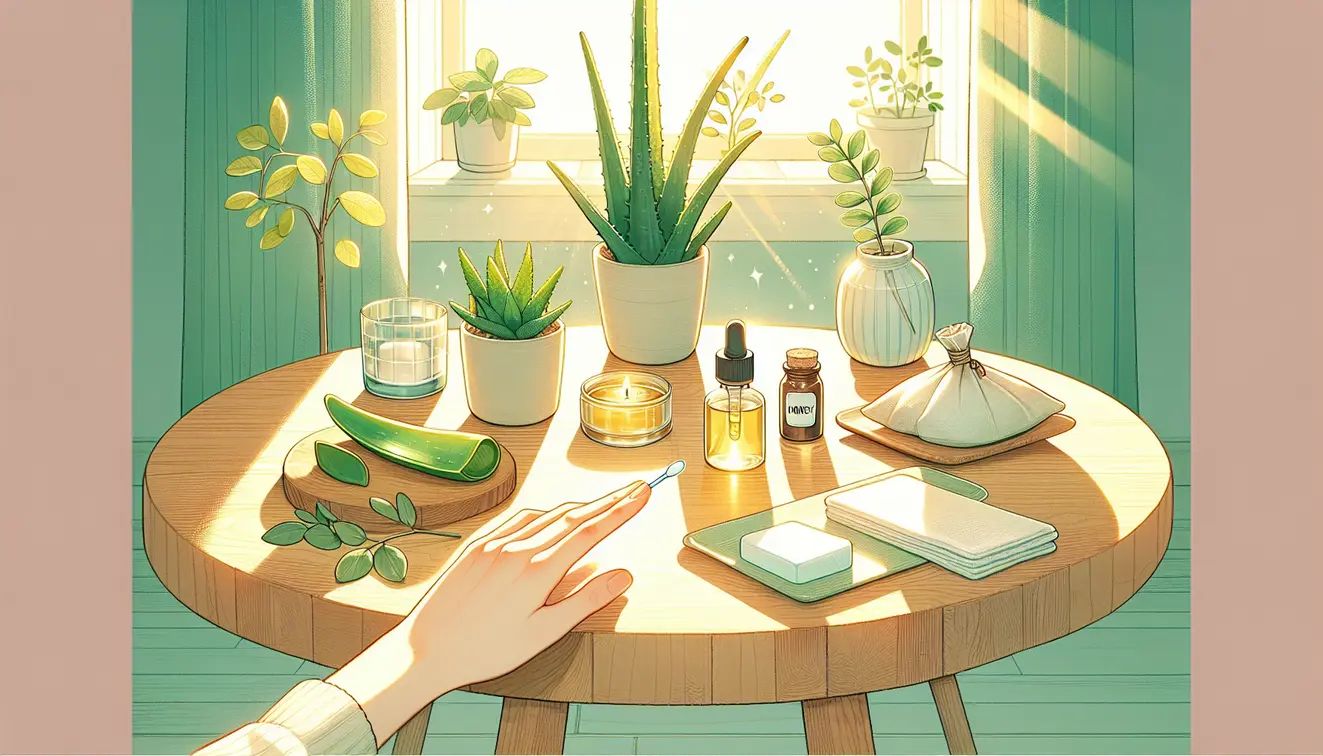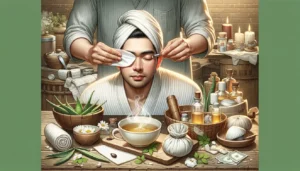Home Remedies for Fever Blisters: Natural Solutions for Quick Relief
Estimated reading time: 8 minutes
Key Takeaways
- Fever blisters, or cold sores, are caused by the herpes simplex virus (HSV-1) and affect over 60% of people worldwide.
- Natural remedies like aloe vera, tea tree oil, and honey can soothe pain and speed healing when used correctly.
- Timing and hygiene are critical—apply remedies early and always keep the area clean to avoid spreading the virus.
- Prevent outbreaks by managing stress, using SPF lip balm, and eating lysine-rich foods.
- Seek medical help if blisters persist, spread, or come with severe symptoms.
Table of Contents
- Introduction to Fever Blisters and Natural Healing
- Understanding Fever Blisters: Causes and Symptoms
- Top 12 Home Remedies for Fever Blisters
- How to Apply Home Remedies Effectively
- Preventing Future Fever Blister Outbreaks
- Safety Precautions and Limitations of Home Remedies
- Frequently Asked Questions (FAQs) About Fever Blisters
Introduction to Fever Blisters and Natural Healing
Dealing with fever blisters, often called cold sores, can be a real nuisance. These small, painful sores around the mouth or lips often bring discomfort and frustration. At WikiHomeRemedies, we understand how much they can interrupt your day, and we’re here to help with gentle, natural solutions.
Fever blisters are caused by the herpes simplex virus, commonly HSV-1. This virus affects a vast number of people—over 60% of the global population carries it, according to the World Health Organization (WHO). While these sores may seem stubborn, nature offers ways to ease the sting and speed up healing.
Why turn to home remedies? They’re often simple to find, easy on the wallet, and rooted in time-tested wisdom. From soothing gels to kitchen staples, these approaches can complement medical care. Plus, they empower you to take small, proactive steps right at home.
In this guide, crafted for 2025 readers, you’ll discover what triggers these bothersome blisters and how to spot them early. We’ll walk you through 12 natural remedies, share tips on safe application, and offer prevention ideas to keep outbreaks at bay. Let’s explore how nature’s gifts can bring you quick relief and restore your comfort. For more insights on managing herpes-related conditions, check out additional resources at WikiHomeRemedies – Home Remedies for Herpes Virus.
Understanding Fever Blisters: Causes and Symptoms
Fever blisters stem from the herpes simplex virus type 1, or HSV-1, which hides in your body until something wakes it up. Once active, it creates those tender, fluid-filled sores near your mouth. Many carry this virus without knowing, as it can stay dormant for years.
What sparks an outbreak? Several culprits can nudge the virus into action. Here are the most common triggers to keep an eye on:
- Stress from work or life events.
- Illness, like a cold or flu, weakening your defenses.
- Sun exposure without lip protection.
- Hormonal shifts, often during menstruation.
These blisters follow a predictable path through distinct stages. First, you might feel a tingling or itching sensation. Then, a small blister forms, which later bursts into a sore before crusting over and healing. Knowing these phases helps you act fast with the right remedy.
While most cases heal on their own, certain signs mean it’s time for a doctor. If the pain becomes severe, outbreaks keep recurring, or you notice swelling and pus, don’t delay seeking help. Safety always comes first, and we at WikiHomeRemedies want you to feel confident in managing your health. Around 20-40% of people face repeated cold sores, per Mayo Clinic data, so understanding when to get support is key. For more focused tips on cold sores, explore this guide at WikiHomeRemedies – Home Remedies for Cold Sore.
Top 12 Home Remedies for Fever Blisters
When fever blisters strike, nature offers a range of solutions to ease discomfort and promote healing. Below, you’ll find 12 carefully selected remedies, each backed by traditional use or scientific insight. We’ve included how to prepare and apply them, along with necessary precautions, so you can proceed with care.
- Ice Pack or Cold Compress
A simple cold compress can numb the area and reduce swelling. Wrap ice in a clean cloth and press it gently on the blister for 10-15 minutes. Repeat every few hours during the early tingling stage. Be mindful not to apply ice directly—it can harm your skin. - Aloe Vera Gel
Known for calming irritated skin, aloe vera gel can help with soreness. Use fresh gel from a plant or a pure store-bought version. Dab it on the blister 2-3 times daily. Watch for any itching, as rare reactions can occur. - Tea Tree Oil
This oil has antiviral traits, noted by Medical News Today, which may fight HSV-1. Dilute a drop with a teaspoon of carrier oil like coconut oil. Apply with a cotton swab twice daily. Never use undiluted—it can burn the skin. - Lemon Balm (Melissa Officinalis)
Lemon balm extract may shorten healing time, per some studies on Healthline. Brew a strong tea or use a cream with the herb. Dab it on the sore up to 3 times a day. Test on a small area first for sensitivity. - Witch Hazel
Witch hazel can dry out blisters with its astringent nature. Soak a cotton ball in pure witch hazel and gently press it on the sore. Do this twice daily. Avoid overusing—it might dry out surrounding skin too much. - Honey (Especially Manuka Honey)
Honey, particularly Manuka, has healing and antimicrobial properties. Spread a thin layer over the blister using a clean finger or swab. Reapply 3-4 times daily. Don’t give honey to infants under one year due to botulism risk. - Lysine Supplements or Foods
Lysine, an amino acid, might curb outbreaks, according to Drugs.com. Take a 1,000 mg supplement daily during an outbreak or eat lysine-rich foods like fish. Consult a doctor before starting supplements, especially if pregnant. - Peppermint Oil
Peppermint oil offers cooling relief and possible antiviral effects. Mix one drop with a teaspoon of carrier oil. Dab it on the sore twice a day. Always dilute to prevent irritation on delicate skin. - Echinacea
Echinacea may boost immunity to fight the virus, per traditional use. Drink it as a tea or take a tincture as directed. Use it at the first sign of a blister. Avoid if you have autoimmune conditions without medical advice. - Garlic
Garlic’s antiviral potential makes it a folk favorite. Crush a fresh clove and mix with a little water to make a paste. Apply sparingly to the sore once daily. Rinse off after 10 minutes to dodge irritation. - Vanilla Extract (Pure)
Pure vanilla extract is an anecdotal remedy for drying sores. Dab a tiny amount on the blister with a cotton swab. Repeat 2-3 times daily. Note that research is limited, so use with caution. - Apple Cider Vinegar (Diluted)
Apple cider vinegar may help dry out blisters due to its acidity. Mix one part vinegar with three parts water. Apply with a cotton ball once a day. Stop if it stings too much, as it can be harsh.
These remedies offer a variety of paths to relief. Choose what feels right for your body, and always prioritize cleanliness to avoid spreading the virus. For broader strategies on managing herpes symptoms, see this helpful resource at WikiHomeRemedies – Home Remedies for Herpes Management.
How to Apply Home Remedies Effectively
Using natural solutions for fever blisters works best when you apply them thoughtfully. Start by sourcing pure, high-quality ingredients—think fresh aloe from a trusted store or unprocessed honey. Always wash your hands before and after touching the sore to keep things clean and prevent the virus from spreading.
Timing plays a big role in how well a remedy works. If you feel tingling, that’s the moment to use a cold compress to slow the blister’s growth. Once the sore forms or bursts, soothing options like aloe vera or honey can calm the area and aid healing. Matching the remedy to the stage ensures you get the most out of nature’s offerings.
How often should you apply these solutions? Most, like aloe or diluted tea tree oil, can be used 2-3 times a day until the sore heals. Don’t overdo it—too much of even a gentle remedy can irritate skin. Stick to this rhythm for a few days, usually 5-7, and stop if you notice redness or unease. Following these steps, rooted in practical health advice from sources like Cleveland Clinic, helps you heal safely.
Preventing Future Fever Blister Outbreaks
Keeping fever blisters away often starts with small, intentional shifts in daily life. Let’s explore ways to strengthen your body and sidestep triggers, ensuring these sores don’t keep coming back.
- Lifestyle Changes for Stress and Immunity
Stress can wake up the HSV-1 virus, so finding calm matters. Practices like yoga or a short walk—about 20 minutes—can lower tension. Pair this with 7-8 hours of sleep to keep your immune system strong. - Dietary Tips to Reduce Recurrence
Foods high in lysine, such as fish or yogurt, may help prevent outbreaks, per Drugs.com. Meanwhile, cut back on arginine-rich options like nuts or chocolate. A balanced plate supports your body’s natural defenses. - Avoiding Common Triggers
Sun exposure often sparks blisters, so use an SPF lip balm every day. Feeling under the weather? Rest up to avoid weakening your system. Staying mindful of these factors cuts down flare-up risks. - Hygiene Practices to Stop Spread
Wash your hands frequently, especially after touching your face. Don’t share utensils or towels, as the virus spreads easily. Simple habits like these, backed by tips from Kaiser Permanente, protect you and others.
Building these habits takes time, but they pave the way for lasting comfort. A steady approach keeps outbreaks in check.
Safety Precautions and Limitations of Home Remedies
While nature provides powerful tools for fever blisters, caution remains essential. Some remedies, like undiluted tea tree oil or apple cider vinegar, can irritate skin if not used properly. Watch for redness or stinging, and stop immediately if these occur, as your comfort is the priority.
Certain groups should steer clear of specific solutions. Honey isn’t safe for infants under one year due to botulism risks, and pregnant individuals should consult a doctor before taking lysine supplements. Those with sensitive skin might also need to skip essential oils, even when diluted. Following guidance from sources like Mayo Clinic ensures you stay on a safe path.
Home remedies often help, but they aren’t a full replacement for medical care. If blisters spread, persist beyond two weeks, or come with fever, it’s time to see a professional. At WikiHomeRemedies, we encourage exploring natural options while knowing their limits. Your health always deserves the best balance of care and caution.
Frequently Asked Questions (FAQs) About Fever Blisters
What’s the Fastest Way to Heal a Fever Blister at Home?
Using a cold compress at the first tingle can slow the blister’s growth. Follow with aloe vera or honey to soothe and heal, applying 2-3 times daily. Early action often cuts healing time.
Can Fever Blisters Spread to Others?
Yes, they’re highly contagious, especially when the sore is open. Avoid kissing or sharing items like lip balm. Wash hands after touching the area to limit spread, per WebMD advice.
How Long Do Fever Blisters Last Without Treatment?
Typically, they heal in 7-10 days, as noted by Healthline. Stages move from tingling to crusting over this period. Remedies can shorten this if started early.
Are There Over-the-Counter Options if Home Remedies Fail?
Yes, creams like docosanol or antiviral ointments can help. Pick these up at a pharmacy if natural methods don’t ease the discomfort. A doctor can guide stronger options too.
Can Diet Really Prevent Fever Blisters?
It can play a role. Eating lysine-rich foods like dairy may lower outbreak chances, while avoiding nuts helps. A steady diet boosts immunity for long-term defense.










